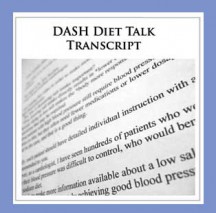DASH Diet Talk Transcript

The following is a transcript of the DASH Diet talk:
DASH Diet Transcript
E. Roehm, M.D. 2011
DASH diet (Dietary Approaches to Stop Hypertension)
My name is Dr. Eric Roehm.
I’m a board certified cardiologist and created this video in order to increase the information available regarding diet and high blood pressure.
This video is about the DASH dietary recommendations which are helpful for high blood pressure.
The DASH diet is not a weight loss diet.
DASH stands for Dietary Approaches to Stop Hypertension, an ambitious goal.It was first reported in a trial sponsored by the National Institutes of Health over 10 years ago.
Later, it was shown that the DASH dietary changes combined with a low sodium diet was even better for lowering blood pressure.
In fact, the DASH diet together with a low sodium diet is as effective as a mild blood pressure pill.
A few years ago, another study made some tweaks to the DASH diet which again increased its effectiveness.
I have made some simplifications and minor modifications in the DASH diet for this video that have made it easier for the patients that I have seen in my office to follow.
More details about DASH diet as described in this talk are available in a link on this website described as the scientific background to the DASH diet, if you have an interest.
The best source of information on the DASH diet is a registered dietician seen locally.
This is recommended to you if you have this as an option.
Now at this point, if you don’t have the handout for this DASH diet video in front of you now, please pause the video and print out the information labeled “DASH diet handout” before proceeding.
Have this sheet available to follow along as the talk proceeds for best results.
[DASH diet handout]
Let’s review the essence of following the DASH diet.
The key to following a DASH diet is increasing fruit and vegetable intake.
Aim for at least 4-5 servings of vegetables per day and aim for 4 servings of fruits per day.
If you are eating more fruits and vegetables than this already, please continue doing so.
Green vegetables, colored vegetables of all shades, and the crucifer family of vegetables that include broccoli and cauliflower are all particularly healthy. The more vegetables, the better.
In regards to fruit, eating the whole fruit is optimal, but one of your fruit servings can be a glass of 100% fruit juice.
Increasing fruit and vegetable intake is not only associated with lower blood pressure, but with a decreased risk of heart disease and cancer as well.
As far as what makes a serving, don’t worry about that too much.
A half cup of cooked vegetables approximates a serving.
I would consider putting up the sheet you printed out about the DASH diet on your refrigerator as a reminder. Make it a game, perhaps with other family members, of seeing how many servings of fruits and vegetables you can eat daily.
And the goals for the DASH diet are not all or none.
Don’t be discouraged, if you increase your total of fruits and vegetables but don’t reach the numbers described. This still benefits your health and blood pressure, just not as much.
Now, continuing with the information on your handout:
Legumes such as beans, lentils, and unsalted nuts are also part of the DASH diet-
have at least 1-2 servings a day from this category.
(One serving a day can be from nuts. Select unsalted nuts without added oil.
A serving is 1½ ounces which is about 1/3 of a cup.)
Even if you are eating nuts, try making beans and lentils a regular part of your diet.
They are quite healthy and the vegetable protein present helps lower blood pressure, as well as potentially having other health benefits.
For grains, make the breads and grains that you eat whole grain.
The very first item on the ingredient list on the package should be a whole grain like “whole wheat”, and not just “wheat flour”.
Examples include whole wheat breads and pastas, whole oats like oatmeal, and brown rice and quinoa.
For meats, emphasize fish as well as white meat choices of chicken and turkey.
For beef and pork, make the meats lean.
For oils, those high in monounsaturated fats such as olive oil or canola oil, have been documented in the Omni Heart Trial to help blood pressure in conjunction with a DASH diet.
Use fat free, or low fat milk products like milk or yogurt.
Preferably use skim, but a useful guide is to routinely limit the fat content of milk and yogurt to a 1% fat content.
Two servings a day of dairy products are consistent with the DASH diet.
And finally, limit sweets and added sugars to 5 or fewer servings per week.
In summary:
For the DASH diet, make a game of trying to eat at least 4-5 vegetables daily, and 4 servings of fruit daily.Try to develop a practice of eating beans, lentils, and unsalted nuts regularly as well.
Use fat free or low fat dairy products.
For meat sources use fish, poultry, and lean meats.
Consider using oils such as olive oil and canola oil.
And use whole grains.
As noted, there is additional written material on the DASH diet which is provided on this site.
For further information, there is also a web link to the National Institutes of Health information on the original DASH diet.
And remember that more complete information can be obtained from a dietician locally, if you have that option.
If you have high blood pressure and haven’t seen the video concerning a low salt diet that is on this website, I recommend you consider viewing that video now.
And finally, I want to wish you good luck in all your efforts in improving your health.
NutritionHeart.com E. Roehm, M.D. 2011
